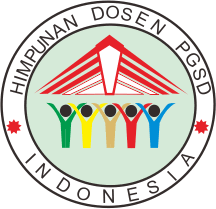Hubungan kecemasan matematika dan kemampuan verbal dengan keterampilan numerasi peserta didik kelas V sekolah dasar
Abstract
This study aims to investigate the relationship between mathematics anxiety, verbal ability, and numeracy skills among fifth-grade elementary school students. Specifically, it examines: (1) the correlation between mathematics anxiety and numeracy skills; (2) the correlation between verbal ability and numeracy skills; and (3) the joint correlation of mathematics anxiety and verbal ability with numeracy skills. The research employed a correlational survey method. The population consisted of fifth-grade students from public elementary schools in Cluster III of the Banjarsari District, comprising approximately 53 schools. A total of 83 students from three schools were selected using a cluster random sampling technique. Data collection instruments included a mathematics anxiety questionnaire and multiple-choice tests for verbal ability and numeracy skills. The results of the analysis show that: (1) there is a significant correlation between mathematics anxiety and numeracy skills (ry1 = -0,431; tcount = 4.295 > ttable = 1.990); (2) there is a significant correlation between verbal ability and numeracy skills (ry2 = 0,423; tcount = 4,196 > ttable = 1.990); and (3) there is a significant simultaneous correlation between mathematics anxiety and verbal ability with numeracy skills (ry12 = 0,531 ; Fcount = 15,692 > Ftable 3,111). These findings highlight the importance of both emotional and cognitive factors in shaping students' numeracy proficiency.
Keywords
References
R. Atasoy and N. Güçlü, 2020 “Evaluation of Numeracy Skills of Adults According to the Results of PIAAC 2015 in Turkey,” World Journal of Education, 10(2), 27, doi: 10.5430/wje.v10n2p27. [2] S. Samsiyah, 2022 “Analisis pelaksanaan pembelajaran berdiferensiasi untuk meningkatkan literasi numerasi siswa di sekolah dasar.” Jurnal Pendidikan Dasar, 10(2). [3] M. Elfert, 2019 “Lifelong learning in Sustainable Development Goal 4: What does it mean for UNESCO’s rights-based approach to adult learning and education?,” International Review of Education, vol. 65, no. 4, pp. 537–556, doi: 10.1007/s11159-019-09788-z. [4] D. D. M. Khasanah and A. M. Putri, 2021 “Penguatan Literasi Numerasi dan Adaptasi Teknologi pada Pembelajaran di Sekolah: (Sebuah Upaya Menghadapi Era Digital dan Disrupsi) Eksponen, 11(2), 25 – 35. [5] OECD, 2023 “PISA 2022 Results (Volume I). in PISA. doi: 10.1787/53f23881-en. [6] Kemendikbud, 2020 “AKM dan Implikasinya pada Pembelajaran.” Pusat Asesmen dan Pembelajaran Badan Penelitian dan Pengembangan dan Perbukuan Kementerian Pendidikan dan Kebudayaan, 1 – 37, https://repositori.kemdikbud.go.id/19690/ [7] E. Nabilah, 2021 “Hubungan Kecemasan Matematika dan Digital Storytelling Terhadap Math Literacy Pada Siswa Sekolah Menengah Pertama dalam Pembelajaran Matematika Pada Kelas Virtual,” vol. 05, no. 03, pp. 2152–2163. [8] A. Zalsabilla, S. Istiyati, and F. P. Adi, 2024 “Analisis kemampuan membaca pemahaman peserta didik kelas V pada pembelajaran Bahasa Indonesia kurikulum merdeka di SDN Cinderejo Surakarta.” JPI (Jurnal Pendidikan Indonesia): Jurnal Ilmiah Pendidikan, 10(2). [9] A. Quraisy, 2022 “Hubungan Kemampuan Numerik Dan Kemampuan Verbal Siswa dalam Pembelajaran Matematika,” JOMTA Journal of Mathematics: Theory and Applications, vol. 4, no. 1, 27 – 29. [10] N. K. Riani, A. Husna, and Y. Gusmania, 2022 “Pengaruh Kemampuan Verbal Dan Kemampuan Numerik Terhadap Kemampuan Literasi Matematis,” AKSIOMA: Jurnal Program Studi Pendidikan Matematika, 11(3), 2359, doi: 10.24127/ajpm.v11i3.5082. [11] E. Khasawneh, C. Gosling, and B. Williams, 2020 “The correlation between mathematics anxiety, numerical ability and drug calculation ability of paramedic students: An explanatory mixed method study,” Adv Med Educ Pract, 11, pp. 869–878, doi: 10.2147/AMEP.S258223. [12] E. Carey, A. Devine, F. Hill, and D. Szucs, 2017 “Differentiating anxiety forms and their role in academic performance from primary to secondary school,” PLoS One, vol. 12, no. 3, doi: 10.1371/journal.pone.0174418. [13] A. Shishigu, 2018 “Mathematics Anxiety and Prevention Strategy: An Attempt to Support Students and Strengthen Mathematics Education,” Mathematics Education Trends and Research, vol. 2018, no. 1, pp. 1–11, 2018, doi: 10.5899/2018/metr-00096. [14] K. Atit et al., 2022 “Examining the relations between spatial skills and mathematical performance: A meta-analysis,” 29(3), 699 – 720. [15] E. Binsasi, 2019 “Pengaruh Kemampuan Verbal dan Kemampuan Numerik terhadap Prestasi Belajar Matematika Siswa SMPS Katolik Aurora Kefamenanu,” Jurnal Saintek Lahan Kering, vol. 2, no. 1, pp. 10–12, doi: 10.32938/slk.v2i1.442. [16] A. Rahmanuri, R. Winarni, A. Surya, 2023 “Faktor-faktor yang memengaruhi literasi matematika: systematic literature review.” Didaktika Dwija Indria, 11(6). [17] A. Parnawi, 2020 “Psikologi-Belajar”, Deepublish.
Refbacks
- There are currently no refbacks.



